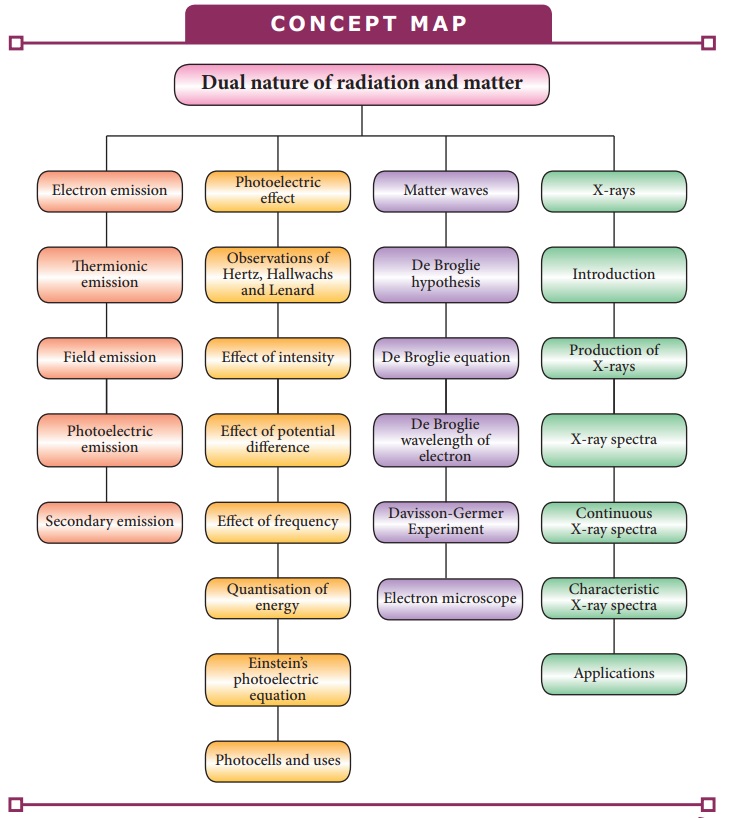Dual Nature of Radiation and Matter | Physics - Summary, Concept Map | 12th Physics : UNIT 8 : Dual Nature of Radiation and Matter
Chapter: 12th Physics : UNIT 8 : Dual Nature of Radiation and Matter
Summary, Concept Map
SUMMARY
• Particle is a
material object which is considered as a tiny concentration of matter
(localized in space and time) whereas wave is a broad distribution of energy (not
localized in space and time).
• The liberation of
electrons from any surface of a substance is called electron emission.
• The
minimum energy needed for an electron to escape from the metal surface is
called work function of that metal.
• 1 eV is equal to 1.602 × 10–19 J.
• The
emission of electrons by supplying thermal energy is known as thermionic
emission.
• Electric
field emission occurs when a very strong electric field is applied across the
metal.
• The
emission of electrons due to irradiation of light is called photoelectric
emission.
• Secondaryemissionistheprocessinwhichelectronsareemittedduetothebombardment
of fast moving electrons.
• The photoelectric
current (i.e. the number of electrons emitted per second) is directly proportional
to the intensity of the incident light.
• Stopping
potential is that the value of the negative (retarding) potential given to the
collecting electrode A which is just
sufficient to stop the most energetic photoelectrons emitted and make the
photocurrent zero.
• The stopping
potential is independent of intensity of the incident light.
• Maximum kinetic
energy of the photoelectrons is independent of intensity of the incident light.
• For a given
surface, the emission of photoelectrons takes place only if the frequency of
incident light is greater than a certain minimum frequency called the threshold
frequency.
• According to
Planck, a matter is composed of a large number of oscillating particles (atoms)
which vibrate with different frequencies.
• According to
Einstein, the energy in light is not spread out over wavefronts but is
concentrated in small packets or energy quanta.
• The individual
light quantum of definite energy and momentum can be associated with a
particle. This particle is named photon.
• Light behaves as
a wave during its propagation and behaves as a particle during its interaction
with matter.
• Photo electric
cell or photo cell is a device which converts light energy into electrical
energy.
• According to de
Broglie hypothesis, all matter particles like electrons, protons, neutrons in
motion are associated with waves. These waves are called de Broglie waves or
matter waves.
• Wave nature of the electron is
used in the construction of microscope called electron microscope.
• De Broglie hypothesis of matter waves was experimentally
confirmed by Clinton Davisson and Lester Germer in 1927.
• Whenever fast moving electrons fall on the materials, a highly
penetrating radiation, x-rays, is emitted.
• Continuous x-ray spectrum consists of radiations of all
possible wavelengths with a certain minimum wavelength λ0 .
• Characteristic x-ray spectra show
some narrow peaks at some well – defined wavelengths when the target is hit by
fast electrons.
CONCEPT MAP

Related Topics